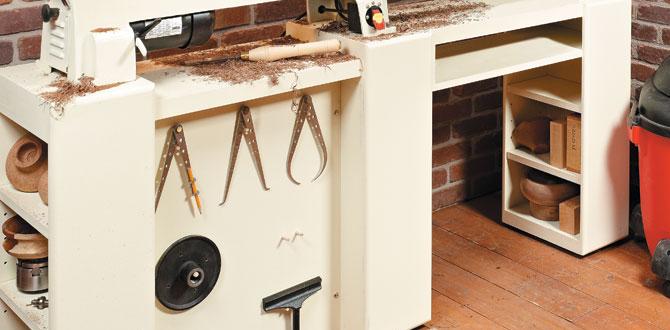Quick Summary:
Use a 35-degree TiAlN ball nose end mill for professional High-Density Polyethylene (HDPE) ramping by setting appropriate speeds, feeds, and depths of cut. This specialized tool excels at smoothly clearing material in angled cuts, preventing melting and achieving clean finishes on HDPE.
Hey everyone, Daniel Bates here from Lathe Hub! Ever found yourself struggling to get those smooth, angled cuts in HDPE plastic? It can be a real headache when your mill just chews up the material, leaving a messy, melted mess. Wouldn’t it be great to achieve those pro-level ramps with confidence? Well, you’re in the right place! Today, we’re diving into how to use a TiAlN ball nose end mill with a 35-degree helix angle specifically for tackling HDPE ramping jobs. Get ready to transform your plastic machining! We’ll walk through it step-by-step, making it simple and safe for your home workshop.
Understanding the 35-Degree TiAlN Ball Nose End Mill for HDPE Ramping
Alright, let’s break down what makes this specific tool so good for working with HDPE, especially when you need to create ramps. HDPE, or High-Density Polyethylene, is a fantastic material for many projects, but it can be a bit tricky to machine. It tends to melt easily if you apply too much heat or use the wrong cutting tools. That’s where our hero of the day comes in: the 35-degree TiAlN ball nose end mill.
What is a Ball Nose End Mill?
First off, what’s a “ball nose” end mill? Unlike a standard flat-end mill, the tip of a ball nose end mill is perfectly rounded, like a ball. This shape is incredible for creating smooth, curved surfaces and, importantly for us, for ramping. When you plunge or ramp into material at an angle, the ball shape allows for continuous contact without a sharp corner digging in. This means less shock and vibration, leading to a cleaner cut.
The Magic of the 35-Degree Helix Angle
Now, about that “35-degree” part. This refers to the helix angle of the flutes (the spiral cutting edges) on the end mill. Imagine the spiral staircase; the angle of the stairs is like the helix angle. A steeper angle (higher degree) usually means smoother cutting in certain materials, while a flatter angle can offer more rigidity. For HDPE, a 35-degree helix angle strikes a sweet spot. It helps to lift chips away efficiently, reducing the chance of them re-cutting and causing heat buildup or melting. It’s a fantastic compromise between aggressive material removal and a smooth cut, which is exactly what we need for clean ramps.
Why TiAlN Coating?
The “TiAlN” stands for Titanium Aluminum Nitride. This is a hard, protective coating applied to the end mill. What does this do for us? Well, TiAlN coatings are brilliant at increasing the tool’s resistance to heat and abrasion. When machining plastics like HDPE, heat is our enemy. This coating helps the end mill stay cooler, last longer, and maintain its sharp edge, ensuring a better finish on your workpiece. It’s like giving your tool a superhero suit!
Why Ramping is Important in Machining
So, why are we specifically talking about “ramping”? In CNC machining and even manual milling, ramping is a cutting strategy where you gradually plunge the tool into the material at an angle, rather than plunging straight down. Think of it like walking down a ramp versus jumping down a step. If you were to plunge a standard end mill straight down into HDPE, it could gouge, melt, and create a really messy hole. Ramping, when done correctly, allows the tool to enter the material smoothly over a wider area. This is crucial for:
- Reducing heat: Spreading the cutting action over a larger surface area and a longer path generates less localized heat.
- Minimizing tool stress: The gradual entry puts less sudden force on the cutting edges and the machine spindle.
- Achieving smooth surfaces: Essential for parts that need precise contours or a clean aesthetic.
- Preventing material melting: This is key for plastics like HDPE.
Using a ball nose end mill enhances this process because its rounded tip is designed to “walk” into the material smoothly at these angles, making ramping much more effective and cleaner than with a flat-end mill.
Setting Up Your CNC for HDPE Ramping
Now that we understand the tool and the technique, let’s get down to the practicalities of setting up your CNC machine. This is where we bridge the gap between theory and practice. We want to dial in the settings to get the best possible results from our 35-degree TiAlN ball nose end mill on HDPE.
Essential Tools and Materials
Before you hit the “go” button, make sure you have everything you need:
- CNC Machine: Of course!
- 35-Degree TiAlN Ball Nose End Mill: The star of our show. Ensure it’s the correct size for your job.
- HDPE Material: Your workpiece. Ensure it’s securely clamped.
- Workholding: Clamps, a vise, or double-sided tape to hold your HDPE firmly.
- Coolant/Lubricant (Optional but Recommended): Sometimes a light mist of air or specialized plastic cutting fluid can help keep things cool.
- Safety Gear: Safety glasses are a must!
- Measuring Tools: Calipers or a ruler to check your dimensions.
Speeds and Feeds: The Golden Rule
This is arguably the most critical part of machining any material, and HDPE is no exception. Getting the speeds and feeds right will prevent melting, ensure tool life, and give you a great finish. For HDPE and ball nose end mills, we generally want to use:
- Slower Spindle Speeds (RPM): HDPE doesn’t require super high speeds. A good starting point is often between 5,000 and 15,000 RPM, depending on the cutter diameter and your machine’s capabilities. Smaller diameter mills might run faster, larger ones slower.
- Faster Feed Rates (IPM or mm/min): This is key to preventing melting. A faster feed rate means the tool is moving through the material quickly, taking a thin chip. This doesn’t give the heat enough time to build up. Think of it as taking a quick, shallow bite rather than a slow, deep gouge.
Finding the exact perfect settings can involve some trial and error, as it depends on the specific grade of HDPE, the exact diameter of your end mill, and the rigidity of your machine. Here’s a general guideline for a 1/4-inch (6mm) diameter 35-degree TiAlN ball nose end mill in HDPE:
| Parameter | Typical Range for HDPE | Notes |
|---|---|---|
| Spindle Speed (RPM) | 6,000 – 12,000 | Start lower, increase if needed. |
| Feed Rate (IPM) | 30 – 60 | Keep it moving! |
| Plunge Rate (IPM) | 15 – 30 | Slower than the cutting feed. |
| Depth of Cut (DOC) per pass | 0.020″ – 0.060″ (0.5mm – 1.5mm) | Shallow passes are better for plastics. |
Important Note: These are starting points! Always refer to the end mill manufacturer’s recommendations if available. You can also find helpful resources online, such as the Machining Plastics guide from the University of Hawaii’s Integrated Training Systems. Always perform a test cut on a scrap piece before committing to your final part.
Setting the Depth of Cut (DOC)
When ramping, you’re essentially controlling how deep the tool penetrates with each spiral pass. For HDPE, it’s best to take shallow, progressive passes. Instead of plunging 1/2 inch straight down in one go, you’ll want to ramp down gradually. This means your CAM software (or manual G-code) will be programmed to make multiple shallow ramps to reach the final depth.
A typical depth of cut per pass for HDPE with a ball nose end mill might be between 0.020 inches (0.5mm) and 0.060 inches (1.5mm). This keeps the chip load light and the heat manageable. The ball nose end mill is excellent here because its entire cutting edge will be engaged over the angled path, spreading the load evenly.
Ramping Strategy in CAM Software
If you’re using CAM software (like Fusion 360, VCarve, Mastercam, etc.), you’ll typically select a “3D Adaptive Clearing,” “Pocket,” or “Contour” toolpath strategy, but crucially, you’ll enable the “Ramp” or “Helical” entry option. The software will then calculate how to move the tool in a circular or spiral path to enter the material at the specified angle and depth. You’ll define:
- The tool (your 35-degree TiAlN ball nose end mill).
- The desired depth of the ramp.
- The ramp angle or stepover distance.
- The stepdown (depth per pass).
The goal is to have the tool enter the material at an angle, often with a ramp angle of around 5 degrees or less in the CAM software’s parameters, allowing it to feed into the beginning of the cut smoothly. The ball nose design is perfect for this gradual entry.
Step-by-Step Guide to Pro HDPE Ramping
Let’s get hands-on. This is the process you’ll follow to achieve those clean, ramping cuts in HDPE.
- Secure Your HDPE:
First things first, make sure your HDPE workpiece is clamped down rock solid. Any movement here means trouble. Use clamps that don’t interfere with your toolpath, or consider using a vise with soft jaws designed for plastic. For smaller jobs, double-sided tape can also work if you have good holding power.
- Install the End Mill:
Carefully install your 35-degree TiAlN ball nose end mill into your CNC spindle. Ensure it’s properly seated and tightened. Double-check that it’s running true.
- Set Your Zero Point (XYZ Origin):
Determine the starting point of your cut. This is usually on the surface of the HDPE (Z-zero) and at a specific X and Y coordinate. Use your machine’s probing routine or carefully jog the spindle to find these points.
- Load Your Toolpath:
Load the G-code generated by your CAM software into your CNC controller. Before you run it, do a “dry run” or “air cut.” This means running the program with the spindle off, but the machine moves as if it’s cutting. Watch carefully to ensure the tool doesn’t crash into clamps or deviate from the intended path. This is crucial for safety and preventing broken tools.
- Initiate the Cut with Low Spindle Speed (Optional Initial Test):
For that very first ramp into the material, you might want to start the spindle at the lower end of your recommended RPM range. Once the tool is engaged and feeding, you can then ramp up to your optimal speed if your machine allows for spindle speed overrides during the program.
- Begin Ramping:
Start the CNC program. The machine will begin executing the ramp toolpath. Watch and listen! You’re looking for a consistent, clean cutting sound. If you hear loud screeching, chattering, or see a lot of smoke or melting plastic, stop the machine immediately and check your speeds, feeds, and depth of cut.
- Monitor the Process:
Keep an eye on the chip formation. You want to see small, wispy chips being ejected cleanly. If the plastic is reforming into larger shavings or getting stringy, it’s likely too hot. This indicates you might need to increase your feed rate or decrease your depth of cut per pass. A light blast of air can also help clear chips and cool the cutting zone.
Here’s a helpful resource from the National Institute of Standards and Technology (NIST) on machining principles, which applies to understanding chip formation and cutting dynamics.
- Multiple Passes:
If your ramp is deep, the CNC will make multiple passes, stepping down incrementally. Each pass should continue the smooth ramping motion until the desired final depth is reached.
- Finishing the Ramp:
Once the machine completes the ramp toolpath, it will move to the next operation. Inspect the ramped surface. It should be smooth and free of excessive melting or fuzzies. If there are minor imperfections, you might be able to clean them up with a deburring tool or a light sanding.
- Clean Up:
After the job is done, turn off the spindle and remove your part. Clean your machine of any plastic chips or dust. Inspect your end mill for any signs of excessive wear or plastic buildup.
Achieving a Pro Finish: Tips and Tricks
Getting that professional-looking finish on HDPE requires a bit of finesse. Here are some extra tips to elevate your ramping game:
Chip Evacuation is King
As mentioned, HDPE melts easily. The best way to prevent this is to get the chips away from the cutting area as fast as possible. This means:
- Air Blast: A directed stream of compressed air onto the cutting zone is highly effective.
- Chip Breakers (Less Common on Plastics): Some specialized end mills have chip-breaking features, but for HDPE, maximizing other chip evacuation methods is more common.
- Tool Stick-Out: Avoid excessive tool stick-out, which can cause chatter and vibration, hindering chip evacuation.
Experiment with Feed and Speed
Don’t be afraid to tweak your settings. If your initial cuts are showing signs of melting, try increasing your feed rate by 10-15%. If the surface finish is rough, you might need to slightly decrease your feed rate or take a lighter depth of cut. For spindle speed, if you’re not getting enough cutting action, a small increase might help, but proceed with caution to avoid overheating.
Tool Condition Matters
A dull or damaged end mill is a recipe for disaster. Always use sharp tools. A TiAlN coating helps maintain sharpness, but even coated tools wear out. If you notice your finish degrading, it might be time to replace your end mill.
Consider Climb vs. Conventional Milling
For plastics, climb milling (where the cutter rotates in the same direction as the feed) is generally preferred. It tends to produce a smoother finish and puts less stress on the tool and workpiece. Most CAM software defaults to this for 3D toolpaths but always double-check.
Material Properties and Temperature
Different types of HDPE can have slightly different melting points and machining characteristics. Warmer ambient temperatures can also increase the tendency for melting. Be mindful of these factors when setting up your cuts.
The Role of Lubrication (Use Sparingly for Plastics)
While flood coolant is generally not recommended for most plastics as it can cause them to swell or become brittle, a very light mist of air or a specialized plastic cutting lubricant can sometimes help manage heat without adverse effects. Always test this on scrap material first. For most HDPE ramping, good speeds/feeds and chip evacuation are sufficient.
Troubleshooting Common Issues
Even with the best tools and techniques, you might run into a snag. Here’s how to tackle common problems:
Problem: Melting Plastic
- Cause: Too much heat generation. This is usually due to slow feed rates, excessive depth of cut, or poor chip evacuation.
- Solution:
- Increase feed rate.
- Decrease depth of cut per pass.
- Improve chip evacuation with an air blast.
- Ensure RPM isn’t excessively high for the material.
Problem: Rough Surface Finish
- Cause: Chatter, dull tool, incorrect feed rate (too fast or too slow), or issues with the material itself.
- Solution:
- Check if the tool is sharp.
- Slightly adjust feed rate.
- Ensure the workpiece is rigidly held.
- Reduce depth








